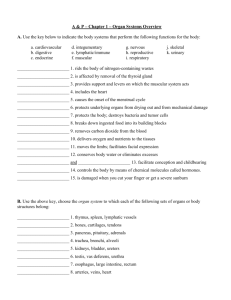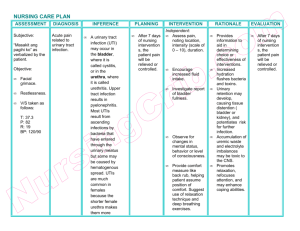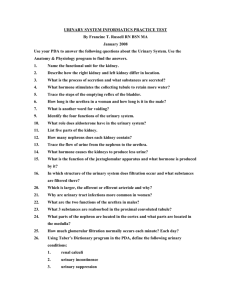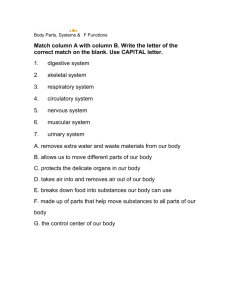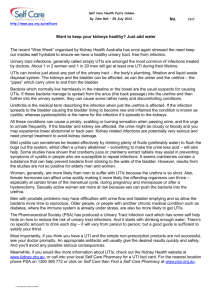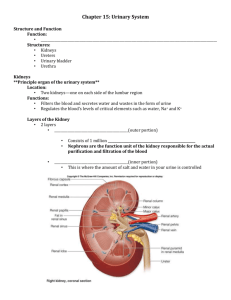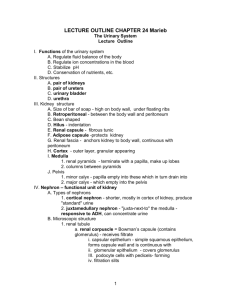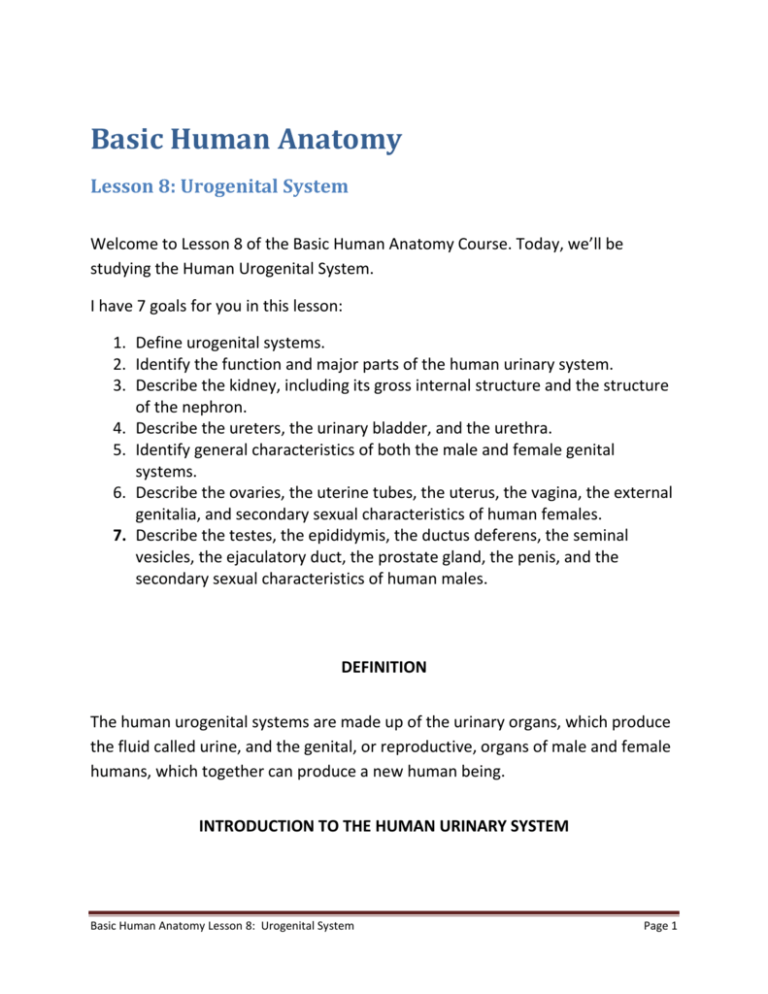
Basic Human Anatomy
Lesson 8: Urogenital System
Welcome to Lesson 8 of the Basic Human Anatomy Course. Today, we’ll be
studying the Human Urogenital System.
I have 7 goals for you in this lesson:
1. Define urogenital systems.
2. Identify the function and major parts of the human urinary system.
3. Describe the kidney, including its gross internal structure and the structure
of the nephron.
4. Describe the ureters, the urinary bladder, and the urethra.
5. Identify general characteristics of both the male and female genital
systems.
6. Describe the ovaries, the uterine tubes, the uterus, the vagina, the external
genitalia, and secondary sexual characteristics of human females.
7. Describe the testes, the epididymis, the ductus deferens, the seminal
vesicles, the ejaculatory duct, the prostate gland, the penis, and the
secondary sexual characteristics of human males.
DEFINITION
The human urogenital systems are made up of the urinary organs, which produce
the fluid called urine, and the genital, or reproductive, organs of male and female
humans, which together can produce a new human being.
INTRODUCTION TO THE HUMAN URINARY SYSTEM
Basic Human Anatomy Lesson 8: Urogenital System
Page 1
a. Proteins are one of the basic foodstuffs that humans consume. When proteins
are used by the body, there are residue or waste products which can be
poisonous (toxic) if allowed to accumulate in large amounts. The urinary system
of the human body is specialized to remove these nitrogenous waste products
from the circulating blood.
b. Major Parts. See figure 8-1 for the major parts of the human urinary system.
This system includes two kidneys, two ureters (one connecting each kidney to the
urinary bladder), the urinary bladder, and the urethra.
Basic Human Anatomy Lesson 8: Urogenital System
Page 2
Figure 8-1. The human urinary system.
Basic Human Anatomy Lesson 8: Urogenital System
Page 3
THE KIDNEY
a. General.
(1) The kidneys have the same shape and color as kidney beans, but are
about 8-10 centimeters (3-3 1/2 inches) in length.
(2) Each kidney has a fibrous capsule. On the concave, medial side of each
kidney, there is a notch called the hilus. Through this hilus pass the ureter
and the NAVL (nerve, artery, vein, and lymphatic) which service the kidney.
(3) Each kidney is attached to the posterior wall of the abdominal cavity,
just above the waistline level. Each is held in place by special fascia and fat.
b. Gross Internal Structure. If we compare the structure of the kidney with that of
a cantaloupe (muskmelon), the renal cortex would correspond to the hard rind,
the renal medulla would correspond with the edible flesh of the melon, while the
renal sinus would correspond to the hollow center (after the seeds have been
removed). The medulla consists of pyramids with their bases at the cortex and
forming peaks, papillae, which empty into the sinus.
PAPILLA = pimple, nipple
See figure 8-2 for a section of the kidney showing the inner structure.
Basic Human Anatomy Lesson 8: Urogenital System
Page 4
Figure 8-2. A section of a human kidney.
c. The Nephron. See figure 8-3 for an illustration of a nephron. Nephrons are the
functional units of the human kidney. Their primary function is to remove the
wastes of protein usage from the blood. In addition, they serve to conserve water
and other materials for continued use by the body. The end result of nephron
Basic Human Anatomy Lesson 8: Urogenital System
Page 5
function is a more or less concentrated fluid called urine. The kidneys contain
great numbers of nephrons, about a million for each kidney. The main
subdivisions of a nephron are the renal corpuscle and a tubular system.
Figure 8-3. A "typical" nephron.
(1) Renal corpuscle. The renal corpuscle has a hollow double- walled sac
called the renal capsule ("Bowman's capsule"). Leading into the capsule is a
very small artery called the afferent arteriole. Within the capsule, this
artery becomes a mass of capillaries known as the glomerulus. An efferent
arteriole drains the blood away from the capsule. The capsule and the
glomerulus together are known as the renal corpuscle.
Basic Human Anatomy Lesson 8: Urogenital System
Page 6
(2) Tubules. Each renal capsule is drained by a renal tubule. The first part of
this tubule runs quite a distance in a coiled formation and is called the
proximal convoluted tubule. A long loop, the renal loop (of Henle), extends
down into the medulla with two straight parts and a sharp bend at the
bottom. As the tube returns to the cortex layer, it once again becomes
coiled and here is known as the distal convoluted tubule.
(3) Filtration/reabsorption. Except for the blood cells and the larger
proteins, the fluid portion of the blood passes through the walls of the
glomerulus into the cavity between the two layers of the renal capsule. This
fluid is called the glomerular filtrate. By a process of taking back
(resorption), the majority of the fluid is removed from the tubules and the
concentrated fluid is called the urine.
d. The Collecting Tubule. The distal convoluted tubules of several nephrons
empty into a collecting tubule. The urine is then passed from the collecting tubule
at the papilla of the medullary pyramid. Several collecting tubules are present in
each pyramid.
e. Renal Pelvis. The renal pelvis is a hollow sac within the sinus of the kidney.
Urine from the pyramids collects into the funnel-shaped renal pelvis. The ureter
then drains the urine from the renal pelvis.
URETERS
The ureters are tubes which connect the kidneys to the urinary bladder. The
smooth muscle walls of the ureters produce a peristalsis (wave-like movement)
that moves the urine along drop by drop.
Basic Human Anatomy Lesson 8: Urogenital System
Page 7
URINARY BLADDER
a. The urinary bladder is a muscular organ for storing the urine. Near the inferior
posterior corners of the urinary bladder are openings where the ureters empty
into the bladder. Also at the inferior aspect of the urinary bladder is the exit, the
beginning of the urethra. The triangular area, between the openings of the
ureters and the urethra, is called the trigone, or base of the urinary bladder.
b. The urinary bladder wall is stretchable to accommodate varying volumes of
urine.
c. Nerve endings called stretch receptors are found in the wall of the urinary
bladder. Usually, the pressure within the urinary bladder is low. However, as the
volume of the enclosed urine approaches the bladder's capacity, stretching of the
wall stimulates the stretch receptors. The cycle of events controlling urination
(voiding or emptying of the urinary bladder) is known as the voiding reflex.
URETHRA
The urethra is a tube which conducts the urine from the urinary bladder to the
outside of the body. It begins at the anterior base of the urinary bladder.
a. Urethral Sphincters. The urethral sphincters are circular muscle masses which
control the passage of the urine through the urethra. There are two urethral
sphincters--an internal urethral sphincter and an external urethral sphincter.
(1) The internal urethral sphincter is located in the floor of the urinary
bladder. It is made of smooth muscle tissue. It is controlled by nerves of the
autonomic nervous system (lesson 11).
Basic Human Anatomy Lesson 8: Urogenital System
Page 8
(2) The external urethral sphincter is more inferior around the urethra in
the area of the pelvic floor. It is made up of striated muscle tissue. It is
controlled by the peripheral nervous system (lesson 11).
b. Male-Female Differences. The female urethra is short and direct. The male
urethra is much longer and has two curvatures. Whereas the female urethra
serves only a urinary function, the male urethra serves both the urinary and
reproductive functions.
INTRODUCTION TO HUMAN GENITAL (REPRODUCTIVE) SYSTEMS
SEXUAL DIMORPHISM
The human male and human female each has a system of organs specifically
designed for the production of new humans. These systems are known as
reproductive or genital systems. Since there are different systems for males and
females, the genital systems are an example of sexual dimorphism.
MORPH = form, shape
DI = two
SEXUAL = according to sex (gender)
SEXUAL DIMORPHISM = having two different forms according to sex
ADVANTAGES OF DOUBLE PARENTING
The existence of two parents for each child means that genetic materials are
recombined to produce a new type. This new type may be an improvement over
Basic Human Anatomy Lesson 8: Urogenital System
Page 9
previous generations.
MAJOR COMPONENT CATEGORIES OF THE GENITAL SYSTEMS
Components of the genital systems may be considered in the following
categories:
a. Primary Sex Organs (Gonads). Primary sex organs produce sex cells (gametes).
A male gamete and a female gamete may be united to form the one-cell
beginning of an embryo (the process of fertilization). Primary sex organs also
produce sex hormones.
b. Secondary Sex Organs. Secondary sex organs care for the product of the
primary sex organ.
c. Secondary Sexual Characteristics. Secondary sexual characteristics are those
traits that tend to make males and females more attractive to each other.
Secondary sexual characteristics help to ensure mating. These characteristics first
appear during puberty (10-15 years of age).
THE HUMAN FEMALE GENITAL (REPRODUCTIVE) SYSTEM
PRIMARY SEX ORGANS (OVARIES)
The primary sex organ in the human female is the ovary. See figure 8-4 for an
illustration of the female genital system. The ovaries are located to the sides of
the upper end of the uterus. They are anchored to the posterior surface of the
broad ligaments. (The broad ligaments are sheets or folds of peritoneum
enclosing the uterus and uterine tubes and extending to the sides of the pelvis.)
a. The ovary produces the egg cell or ovum (ova, plural).
Basic Human Anatomy Lesson 8: Urogenital System
Page 10
b. The ovary produces female sex hormones (estrogens and progesterone).
c. The production of ova is cyclic. One ovum is released in each menstrual period,
about 28 days.
SECONDARY SEX ORGANS
a. Uterine Tubes (Fallopian Tubes, Oviducts). Extending to either side of the
uterus are two muscular tubes which open at the outer ends like fringed
trumpets. The fringe-like appendages encircle the ovaries. At their medial ends,
the uterine tubes open into the uterus. The function of the uterine tubes is to pick
up the ovum when released from the ovary and hold it UNTIL one of the following
happens:
(1) It is fertilized. After fertilization, the initial stages of embryo
development take place. The developing embryo is eventually moved into
the uterus.
(2) The nutrient stored within the ovum is used up and the ovum dies. This
may take three to five days.
Basic Human Anatomy Lesson 8: Urogenital System
Page 11
Figure 8-4. The human female genital system.
Basic Human Anatomy Lesson 8: Urogenital System
Page 12
b. Uterus. The uterus is the site where all but the first few days of embryo
development takes place. After eight weeks of embryonic development, it is
known as the fetus.
(1) Main subdivisions. The uterus is shaped like a pear, with the stem
(cervix) facing downward and toward the rear. The fundus is the portion of
the uterus above the openings of the uterine tubes. The main part, or body,
is the portion between the cervix and the fundus. The uterus usually leans
forward with the body slightly curved as it passes over the top of the
urinary bladder. The cervix opens into the upper end of the vagina.
(2) Wall structure. The inner lining of the uterus is called the endometrium.
Made up of epithelium, it is well supplied with blood vessels and glands.
The muscular wall of the uterus is called the myometrium. In the body of
the uterus, the muscular tissue is in a double spiral arrangement. In the
cervix, it is in a circular arrangement.
(3) Age differences. The uterus of an infant female is undeveloped. During
puberty, the uterus develops. The uterus of an adult is fully developed. The
uterus of an old woman is reduced in size and nonfunctional.
c. Vagina. The vagina is a tubular canal connecting the cervix of the uterus with
the outside. It serves as a birth canal and as an organ of copulation. It is capable
of stretching during childbirth. The lower opening of the vagina may be partially
closed by a thin membrane known as the hymen.
d. External Genitalia. Other terms for the external genitals of the human female
are vulva and pudendum. Included are the:
(1) Mons pubis. The mons pubis is a mound of fat tissue covered with skin
and hair in front of the symphysis pubis (the joint of the pubic bones).
Basic Human Anatomy Lesson 8: Urogenital System
Page 13
(2) Labia majora. Extending back from the mons pubis and encircling the
vestibule (discussed below) are two folds known as the labia majora. Their
construction is similar to the mons pubis, including fatty tissue and skin.
The outer surfaces are covered with hair. The inner surfaces are moist and
smooth. The corresponding structure in the male is the scrotum.
LABIA = lips (LABIUM, singular)
(3) Labia minora. The labia minora are two folds of skin lying within the labia
majora and also enclosing the vestibule. In front, each labium minus (minus =
singular of minora) divides into two folds. The fold above the clitoris (discussed
below) is called the prepuce of the clitoris. The fold below is the frenulum.
(4) Clitoris. The clitoris is a small projection of sensitive erectile tissue which
corresponds to the male penis. However, the female urethra does not pass
through the clitoris.
(5) Vestibule. The cleft between the labia minora and behind the clitoris is called
the vestibule. It includes the urethral opening in front and the vaginal opening
slightly to the rear.
e. Pregnancy and Delivery. When an embryo forms an attachment to the
endometrium, a pregnancy exists. The attachment eventually forms a placenta,
an organ joining mother and offspring for such purposes as nutrition of the
offspring. The fetal membranes surround the developing individual (fetus) and are
filled with amniotic fluid.
(1) During the first eight weeks, the developing organism is known as an
embryo. During this time, the major systems and parts of the body develop.
Basic Human Anatomy Lesson 8: Urogenital System
Page 14
(2) During the remainder of the pregnancy, the developing organism is
known as the fetus. During this time, growth and refinement of the body
parts occur.
(3) Parturition is the actual delivery of the fetus into a free- living state. The
delivery of the fetus is followed by a second delivery-- that of the placenta
and fetal membranes.
f. Menstruation and Menopause. About two weeks after an ovum is released, if it
is not fertilized, menstruation occurs. Menstruation involves the loss of all but the
basal layer of the endometrium. This process includes bleeding. It first occurs at
puberty and lasts until menopause (45 to 55 years of age). After menopause,
pregnancy is no longer possible.
SECONDARY SEXUAL CHARACTERISTICS
The secondary sexual characteristics of females include growth of pubic hair,
development of mammary glands, development of the pelvic girdle, and
deposition of fat in the mons pubis and labia majora.
MAMMARY GLANDS
The mammary glands were previously mentioned in Lesson 3. Secretion of milk
begins after parturition. Stimulation from suckling helps to maintain the normal
rate of milk secretion. At the time of menopause, breast tissue becomes less
prominent.
THE HUMAN MALE GENITAL (REPRODUCTIVE) SYSTEM
PRIMARY SEX ORGANS (TESTES)
Basic Human Anatomy Lesson 8: Urogenital System
Page 15
The primary sex organ of the human male is the testis. See figure 8-5 for an
illustration of the male genital system. The testes are egg-shaped.
Figure 8-5. The human male genital system.
Basic Human Anatomy Lesson 8: Urogenital System
Page 16
a. Location. The paired testes lie within the scrotum. The scrotum is a sac of loose
skin attached in the pubic area of the lower abdomen. The scrotum provides a
site cooler than body temperature to maintain the viability of the spermatozoa.
However, when the air is too cold, muscles and muscular fibers draw the testes
and scrotum closer to the body to maintain warmth. Otherwise, the scrotum
hangs loosely. The tunica vaginalis is a serous cavity surrounding each testis.
b. Functions. The testis produces the male sex cells called spermatozoa
(spermatozoon, singular). The spermatozoa are continuously produced by the
millions. One such cell may eventually fertilize an ovum of a human female. The
testes also produce male sex hormones called androgens.
SECONDARY SEX ORGANS
a. Epididymis. The epididymis is a coiled tube whose function is to aid in the
maturation of spermatozoa. Its coiled length is only about one and one-half
inches. Its uncoiled length is about 16 feet. When coiled, it extends downward
along the posterior side of each testis. Its lining secretes a nutritive medium for
spermatozoa. It receives spermatozoa from the testes in an immature state. As
the spermatozoa pass through the nutrient, they mature.
b. Ductus (Vas) Deferens. The ductus deferens is a transporting tube which
carries the mature sperm from the epididymis to the prostate. Each tube enters
the abdomen through the inguinal canal. Each passes over a ureter to reach the
back of the urinary bladder and then down to the prostate gland.
c. Seminal Vesicles. Lying alongside each ductus deferens as it crosses the back of
the bladder is a tubular structure called the seminal vesicle. The seminal vesicle
produces a fluid which becomes part of the ejaculate.
Basic Human Anatomy Lesson 8: Urogenital System
Page 17
d. Ejaculatory Duct. Each ductus deferens and its corresponding seminal vesicle
converge to form a short tube called the ejaculatory duct. The ejaculatory duct
opens into the urethra within the prostate gland. The ejaculatory duct carries
both spermatozoa and seminal vesicle fluid.
e. Prostate Gland. As the urethra leaves the urinary bladder, its first inch is
surrounded by a chestnut-size gland called the prostate gland. The prostate gland
provides an additional fluid to be added to the spermatozoa and seminal vesicle
fluid.
f. Penis. As the urethra leaves the abdomen, it passes through the penis, the male
organ of copulation.
(1) Surrounding the urethra is a central cylinder of erectile tissue called the
corpus spongiosum. This cylinder is bulb-shaped at each end. The posterior
end is attached to the base of the pelvis. The sensitive anterior end is
known as the glans.
CORPUS SPONGIOSUM = spongy body
(2) Overlying the corpus spongiosum is a pair of cylinders of erectile tissue
called the corpora cavernosa. These two cylinders are separate in their
proximal fourth and joined in their distal three-fourths. They are attached
to the pubic bones. Together, the corpus spongiosum and the corpora
cavernosa combine to form the shaft of the penis.
CORPUS CAVERNOSUM = cavernous body
(3) The prepuce, or foreskin, is a covering of skin for the glans. It may be
removed in a surgical procedure called circumcision.
Basic Human Anatomy Lesson 8: Urogenital System
Page 18
SECONDARY SEXUAL CHARACTERISTICS
The secondary sexual characteristics of male include growth of facial, pubic, and
chest hair; growth of the larynx to deepen the the voice; and deposition of
protein to increase muscularity and general body size.
Introduction to Basic Human Anatomy is a distance learning product that is based on the
Correspondence Subcourse MD0006 of the U.S. Army Medical Department Center and School.
This presentation was produced by the Brookside Associates, Ltd., which is privately-held and
not connected to any governmental agency. The views expressed here are those of the authors,
and unless otherwise noted, do not necessarily reflect the views of the Brookside Associates,
Ltd., any governmental agencies or private organizations. This presentation is unclassified, and
© 2009, with all rights reserved.
Basic Human Anatomy Lesson 8: Urogenital System
Page 19

